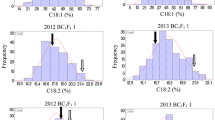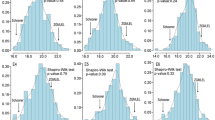Abstract
Rapeseed meal is a rich vegetable protein source because of its balanced amino acid content. Lysine, threonine and methionine are three limiting essential amino acids for livestock and poultry on whose inheritance there is little information available especially at molecular level across different environments. In present study, quantitative trait locus (QTL) identification and analysis for these three important amino acids in rapeseed meal were conducted using two backcross populations derived from 202 double haploid lines of an elite hybrid cross “Tapidor × Ningyou7 (TN)” and their parents. A newly developed QTL model and related mapping software were used to analyze the genetic main effects and QTL × environment (QE) interaction effects for QTLs located in the embryo and maternal genomes, respectively. The results revealed 17 QTLs associated with lysine, threonine and methionine contents in rapeseed meal, 10 of which were in the A sub-genome and the rest in C sub-genome of Brassica napus L., showing significant embryo and maternal genetic effects. Among these QTLs, two were also found to have significant QE interaction effects. In addition, some QTLs were located at the same position or linkage group, such as three QTLs (qLysC-4-2, qThrC-4-2 and qMetC-4-2) in A4 linkage group and two (qThrC-7-3 and qMetC-7-3) in A7 linkage group were co-localized, and three (qLysC-1-1, qThrC-1-1 and qMetC-1-1) were distributed in the same A1 linkage group. qLysC-1-1, qThrC-12-5 and qMetC-7-3 were the major QTLs, which could explain 25.4, 36.7 and 16.4 % of their phenotypic variations, respectively. The genetic main effects and the QE interaction effects of QTLs from embryo and maternal genomes were important for these limiting essential amino acids. The results above might be helpful for marker-assisted selection in rapeseed breeding and cloning of functional genes relevant to lysine, threonine and methionine contents.




Similar content being viewed by others
References
Huisman J, Tolman GH (1990) Antinutritional factors in the plant proteins of diets for non-ruminants. In: Haresign M, Cole DJA (eds) Recent advances in animal nutrition. Butterworth-Heinemann, Oxford, pp 3–31
Galili G, Amir R (2013) Fortifying plants with the essential amino acids lysine and methionine to improve nutritional quality. Plant Biotechnol J 11:211–222
Wang XU, Qiao SY, Yin YL, Yue LY, Wang ZY, Wu GY (2007) A deficiency or excess of dietary threonine reduces protein synthesis in jejunum and skeletal muscle of young pigs. J Nutr 137:1442–1446
Wu JG, Shi CH, Zhang HZ (2005) Genetic analysis of embryo, cytoplasmic and maternal effects and their environment interactions for protein content in Brassica napus L. Aust J Agric Res 56(1):69–73
Ren YL, Shi CH, Wu JG, Zhang HZ (2005) Analysis of embryo, cytoplasmic and maternal effects on 3 amino acid traits in rapeseed. J Zhejiang Univ (Agric Life Sci) 31:41–46 (in Chinese)
Chen GL, Wu JG, Shi CH (2011) Dynamic genetic effects on threonine content in rapeseed (Brassica napus L.) meal at different developmental stages. Czech J Genet Plant Breed 47(3):101–113
Cui YH, Casella G, Wu RL (2004) Mapping quantitative trait loci interactions from the maternal and offspring genomes. Genetics 167:1017–1026
Yang J, Zhu J, Williams RW (2007) Mapping the genetic architecture of complex traits in experimental populations. Bioinformatics 23:1527–1536
Shi CH, Shi Y, Lou XY, Xu HM, Zheng X, Wu JG (2009) Identification of endosperm and maternal plant QTLs for protein and lysine contents of rice across different environments. Crop Pasture Sci 60(3):295–301
Zheng X, Wu JG, Lou XY, Xu HM, Shi CH (2008) The QTL analysis on maternal and endosperm genome and their environmental interactions for characters of cooking quality in rice (Oryza sativa L.). Theor Appl Genet 116(3):335–342
Liu HY, Quampah A, Chen JH, Li JR, Huang ZR, He QL, Zhu SJ, Shi CH (2013) QTL mapping based on different genetic systems for essential amino acid contents in cottonseeds in different environments. PLoS One 8(3):e57531
Liu HY, Quampah A, Chen JH, Li JR, Huang ZR, He QL, Shi CH, Zhu SJ (2012) QTL analysis for gossypol and protein contents in upland cottonseeds with two different genetic systems across environments. Euphytica 188(3):453–463
Quampah A, Liu HY, Xu HM, Li JR, Wu JG, Zhu SJ, Shi CH (2012) Mapping of quantitative trait loci for oil content in cotton seed kernel. J Genet 91:289–295
Qiu D, Morgan C, Shi J, Long Y, Liu J, Li R, Zhuang X, Wang Y, Tan X, Dietrich E, Weihmann T, Everett C, Vanstraelen S, Beckett P, Fraser F, Trick M, Barnes S, Wilmer J, Schmidt R, Li J, Li D, Meng J, Bancroft I (2006) A comparative linkage map of oilseed rape and its use for QTL analysis of seed oil and erucic acid content. Theor Appl Genet 114:67–80
Chen GL, Zhang B, Wu JG, Shi CH (2011) Nondestructive assessment of amino acid composition in rapeseed meal based on intact seeds by near-infrared reflectance spectroscopy. Anim Feed Sci Technol 165:111–119
Shi JQ, Li RL, Qiu D, Jiang CC, Long Y, Morgan C, Bancroft I, Zhao JY, Meng JL (2009) Unraveling the complex trait of crop yield with quantitative trait loci mapping in Brassica napus. Genetics 182:851–861
McCouch SR, Cho YG, Yano PE, Blinstrub M, Morishima H, Kinoshita T (1997) Report on QTL nomenclature. Rice Genet Newsl 14:11–13
Mackay TF (2001) The genetic architecture of quantitative traits. Annu Rev Genet 35:303–339
Paterson AH, Lander ES, Hewitt JD, Peterson S, Lincoln SE, Tanksley SD (1988) Resolution of quantitative traits into Mendelian factors using a complete linkage map of restriction fragment length polymorphisms. Nature 335:721–726
Tanksley SD (1993) Mapping polygenes. Annu Rev Genet 27:205–233
Jansen RC (1993) Interval mapping of multiple quantitative trait loci. Genetics 135:205–211
Jansen RC, Stam P (1994) High resolution of quantitative traits into multiple loci via interval mapping. Genetics 136:1447–1455
Lander ES, Bostein D (1989) Mapping mendelian factors underlying quantitative traits using RFLP linkage maps. Genetics 121:185–199
Wang DL, Zhu J, Li ZK, Paterson AH (1999) Mapping QTLs with epistatic effects and genotype × environment interactions by mixed linear model approaches. Theor Appl Genet 99:1255–1264
Wu WR, Li WM (1994) A new approach for mapping quantitative trait loci using complete genetic marker linkage maps. Theor Appl Genet 89:535–539
Zeng ZB (1994) Precision mapping of quantitative trait loci. Genetics 136:1457–1468
Chen GL, Wu JG, Shi CH (2011) Analysis of embryo, cytoplasmic and maternal genetic correlations for seven essential amino acids in rapeseed meal (Brassica napus L.). J Genet 90:67–74
Hu ZQ, Xu CW (2005) A new statistical method for mapping QTLs underlying endosperm traits. Chin Sci Bull 50:1470–1476
Si P, Mailer JM, Galwey N, Turner DW (2003) Influence of genotype and environment on oil and protein concentrations of canola (Brassica napus L.) grown across southern Australia. Aust J Agric Res 54:396–407
Zhao JY, Becker HC, Zhang DQ, Zhang YF, Ecke W (2005) Oil content in a European × Chinese rapeseed population: QTL with additive and epistatic effects and their genotype-environment interactions. Crop Sci 45:51–59
Yan XY, Li JN, Fu FY, Jin MY, Chen L, Liu LZ (2009) Co-location of seed oil content, seed hull content and seed coat color QTL in three different environments in Brassica napus L. Euphytica 170:355–364
Stein A, Wittkop B, Liu LZ, Obermeier C, Friert W, Snowdon RS (2013) Dissection of a major QTL for seed colour and fibre content in Brassica napus reveals colocalization with candidate genes for phenylpropanoid biosynthesis and flavonoid deposition. Plant Breed 132:382–389
Acknowledgments
The project was financially supported from Zhejiang Provincial Key Laboratory of Crop Germplasm Resources, Foundation for University Key Teacher by the Ministry of Education of China and by the 151 Program for the Talents of Zhejiang Province. We are granted for A. Quampah providing good suggestion when revising this paper.
Conflict of interest
None.
Compliance with Ethics Requirements
This article does not contain any studies with human or animal subjects.
Author information
Authors and Affiliations
Corresponding author
Rights and permissions
About this article
Cite this article
Xu, J., Long, Y., Wu, J. et al. QTL mapping and analysis of the embryo and maternal plant for three limiting amino acids in rapeseed meal. Eur Food Res Technol 240, 147–158 (2015). https://doi.org/10.1007/s00217-014-2316-7
Received:
Revised:
Accepted:
Published:
Issue Date:
DOI: https://doi.org/10.1007/s00217-014-2316-7




